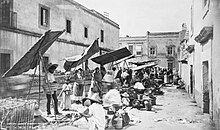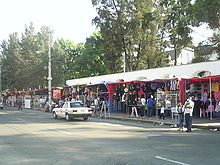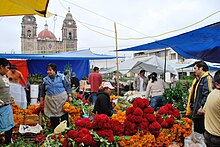Tianguis
This market served about one fifth of the population of Tenochtitlan (Mexico City) before the Conquest and had its own governing system, which included a panel of twelve judges to resolve disputes.
In all these cases, vendors eventually retook the plaza[10] This problem was again tackled in the 1990s as part of an effort to revitalize the historic center of Mexico City.
[12] In the 20th century, local governments in Mexico have promoted municipal or public markets or mercados to better regulate the selling of goods traditionally available in tianguis.
Surveys of consumers have shown that many Mexicans buy from tianguis because of the frequent lack of bargains, social interaction, and customer service in formal stores.
The most common items sold in tianguis include groceries, beauty supplies, clothing, appliances, electronics, prepared foods, tools and used goods.
[17] In the most traditional of tianguis, public officials will close off a street to vehicle traffic on a specified day so that merchants (called “ambulantes”) can set up their spaces on the sidewalks and/or roadways.
It brings basic staples such as vegetables, fruit, clothing as well as crafts and traditional sweets to a neighborhood that does not have a permanent market or supermarket.
On Saturdays in La Lagunilla, stands selling leather, coats and jackets, vintage clothes and other items crowd the streets.
The job of administrators is to interact with local authorities on behalf of tianguis sellers and manage internal affairs, especially the assignment of spaces and the collection of rental fees.
In one market in Zaculapan, 150 of 400 vendors state that they accept bartered goods, especially in produce and staple food products such as milk and bread.
One example is the Sunday market of Cuetzalan, Puebla, where Nahuatl speaking people can be heard negotiating prices on items such as vanilla beans, handcrafted textiles, huipils, coffee, flowers and baskets much as their ancestors did.
The market fills an important retail and social gap as most of the outlying villages are too small to support permanent stores and many use the opportunity to converse with distant neighbors.
[18] The tianguis of Chilapa, Guerrero attracts thousands of Nahua and Tlapaneco people, who come to buy and sell handcrafts, medicinal plants, local specialties such as pozole and many other items.
[9] The weekly Thursday market in Villa de Zaachila is divided into three parts, one devoted to firewood, as many still cook with it, one to livestock and the rest to basic staples.
Those who sell audio and video CDs, a lucrative business, will often have large loudspeakers playing samples of their wares at very high volume.
[5] The largest tianguis in Mexico City is San Felipe de Jesus, which is located on the border of Gustavo A. Madero and Tlalnepantla.
[31] However, many authorities readily admit that they do not have the manpower to enforce laws and regulations in large, crowded and numerous tianguis, although raids are performed sporadically, especially looking for stolen and counterfeit merchandise.
According to Iztalapalpa officials, vendors at the El Salado tianguis set up shop as early as 4 or 5 am in order to receive stolen and other merchandise from trucks behind the Unidad Habitacional Concordia Zaragaza housing complex, and use radios to communicate and watch out for authorities Officials claim there are at least ten places in the market that sell drugs and two that sell guns.
[29] PROFECO, Mexico's consumer protection agency, advises strong caution when shopping in tianguis as it is extremely difficult to help those who have been a victim of fraud.
[8] The main problem with tianguis is that merchants spread out their wares over sidewalks and other public spaces beyond where they are authorized, blocking pedestrian and vehicular traffic.
Lastly, at the end of the day after the stands are taken down and brought home, tons of garbage is left behind, and in areas where market activity is frequent, infrastructure such as light poles and sidewalks are damaged.
[8][35] Despite the problems and despite the fact that tianguis merchants do not pay taxes, rent or services (however bribes are paid to many city officials[36]) like established businesses do, eliminating them or even moving them is very difficult due to the large number of people they employ and their firm place in the culture.
One semi permanent market is the “Fashion Tianguis,” with about fifty vendors who sell clothing each weekend at Parque México in Mexico City.
Other tianguis that specialize in fashion include Plaza Cibeles on weekends, La Lagunilla on Sundays, and Del Chopo on Saturdays.
[39] The city of Tonalá, Jalisco, sponsors a tianguis adjacent to the permanent market, which is restricted mostly to vendors who sell locally made pottery and other craft items.
In San Pablo Tultepec, there is a tianguis of fireworks in August and the first part of September before the annual Independence Day celebrations in Mexico.
[42] In Saltillo every Thursday during Lent, there is a tianguis devoted entirely to fish and seafood, partially sponsored by the federal Secretariat of Agriculture, Livestock, Rural Development, Fisheries and Food agency.
[43] A number of municipalities, such as Hermosillo, Tepic, Xalapa and Celaya, sponsor tianguis for back-to-school, in order to allow parents to buy uniforms, school supplies and other needs at lower prices.
Every year the indigenous and folk art tianguis is held in Uruapan during Holy Week, which is a major vacation time in Mexico.
The promotional literature states that it is the largest tianguis of its kind in the Western Hemisphere, and is accompanied by arts contests, parades and banquets.












